Cara Caras are tasting like candy here in mid-February. They’re like a pink Jolly Rancher – even though they’re an “orange.”
I hear of people harvesting Cara Caras around Christmas, and the entry for Cara Cara navel orange in the University of California at Riverside’s Citrus Variety Collection says the harvest there is November to January, but the fruit from my tree in San Diego County are always sour until well after Christmas. The last half of February is usually the period of best flavor and highest quality for fruit off my Cara Cara tree. And in fact, I once tasted Cara Caras from a tree in the Riverside Collection in early March and they tasted excellent – full, sweet flavor, and still full of juice.
If you’ve only had Cara Caras from a grocery store, you might not know how good they can taste. The primary goal of farmers is not to pick fruit at their peak of eating quality. Only from a backyard tree can you discover the taste potential of a fruit.
This post will profile the Cara Cara fruit, tree, and a bit of history so that you can decide if it deserves space in your garden. Does Cara Cara have what it takes to merit a piece of ground in your yard?
The Cara Cara navel orange fruit
Sometimes called Cara Cara pink navel orange, the fruit’s distinction is its color. Outside, it looks just like any navel orange, but inside you find flesh the color of a “red” grapefruit.
Where does this pigment come from? It’s said to be lycopene, a “red carotenoid pigment with antioxidant properties, most commonly found in plants such as tomatoes,” according to UC Riverside researchers.
This is in contrast to blood oranges. Cara Cara is not a blood orange. Blood oranges (varieties such as Moro, Tarocco, and Sanguinelli) get their more purple coloring from anthocyanin, and often blood oranges hint at the color of their flesh inside with a blush of red or purple on their rinds.
In addition, blood oranges often have streaked or blotchy coloring, similar to tie dye, whereas a Cara Cara’s coloring is more uniform.
Do the compounds that impart coloring also affect flavor? People talk of tasting cherry, rose petal, raspberry, and blackberry in a Cara Cara. (They often say similar things about the flavor of blood oranges.) But I’m unconvinced. I used to think I tasted those notes also. Nowadays, I suspect that the color of the flesh causes people to think they taste such elements. Note that these elements are also pink, red, or purple.
I doubt I could tell the difference between a Washington navel and a Cara Cara in a blind taste test. Could others?
Yesterday, I set up two of my kids and my mom. First, we ate a bunch of both. Then I handed my kids – whose eyes were closed – a wedge of Washington. “Taste it and then tell me which you think it is before opening your eyes,” I said.
“Cara Cara!” said my son. Wrong.
“Cara Cara!” said my daughter. Wrong.
Could my mom do better? I handed her a wedge of Cara Cara. She took her time considering its taste with her eyes closed. “This has to be Cara Cara,” she said. Right!
How did she know? “Cara Cara has something melodious,” she said. I don’t know what that means, but I guess she tasted it (and didn’t hear it?).
Regardless, if you think you taste something more complex and interesting in a Cara Cara pink navel compared to a regular orange Washington navel, then you are still experiencing it in some way, and that might be enough to prefer it over an orange orange.
More objectively, like the Washington navel, Cara Caras are considered seedless. From my tree, I find a single seed in about every five fruit. And there is a belly button on the bottom of both.
Cara Caras don’t peel as well as Washington navels, however. I’ve eaten Cara Caras and Washington navels off many different trees over the years and overall the Washingtons always peel more easily. This is curious because Cara Cara came from a mutation found on a Washington navel tree.
Cara Cara variety history
The story goes that in 1976 a single branch on a Washington navel orange tree growing on Hacienda Cara Cara in Venezuela was noticed to be making fruit that was pink inside. The branch was a “sport,” as it’s called, a natural mutation.
These sports happen relatively often on citrus trees compared to other types of fruit trees. You can see other sports that have occurred on other Washington navel orange trees over the years and have been considered worth preserving (not all mutations are for the better) on this page called, “Holdings of the University of California Citrus Variety Collection Navel orange.”
(And in fact, an interesting sport was found on a Cara Cara tree where the mutated branch was making leaves and fruit that were variegated, meaning they appear green and white striped. The fruit’s rind is green and white striped while the inside remains the normal pink. [See “Variegated Cara Cara” here.])
Anyway, the sport branch found in 1976 on the tree in Venezuela was grafted onto other trees and continued to make fruit that was pink inside. The mutation was stable.
A few years later, the novel navel was brought up to Florida and then onto California. What a strange circle!
As I wrote about in another post (“Saving the Parent Washington navel orange tree”), the Washington navel orange was discovered in Brazil in the 1870s. It was sent up to the USDA greenhouses in Washington, D.C. (gaining the “Washington” part of its name) and then onto California where it thrived and spread from an epicenter at Riverside. The Washington navel orange tree then was distributed from the Riverside plantings throughout the world, including back down into South America, at Hacienda Cara Cara in Venezuela. A century later, in the 1970s . . .
The tree
I planted a Cara Cara tree from a five-gallon container in my yard in 2015. So at the time of writing, this tree has been in the ground for about seven years.
In that time it has never had a year without fruit, and in fact its production has been very consistent. I would estimate that this year the tree carried 70 oranges.
The tree is currently almost six feet tall and just as wide. In terms of growth, I’d call it moderately vigorous, not a runt and not a rocket. It is growing near a Gold Nugget mandarin tree and a Kishu mandarin tree, both of which were planted one year earlier and on the same rootstock (C-35 citrange). I water and fertilize all of these trees the same, and the growth of the Cara Cara has been slightly slower than Gold Nugget but slightly faster than Kishu.
Other Cara Cara trees that I know in other yards are similarly productive and vigorous compared to mine.
Comparing foliage color, Cara Cara wins. It has deeper green and larger leaves versus those mandarins. It is like other oranges, whose trees are always prettier than mandarins.
In case you’re curious, my Cara Cara is watered with drip emitters and I maintain a deep mulch of wood chips under the tree at all times but have never added other forms of fertilizer.
As for toughness, my Cara Cara has gone through many days with temperatures in the 110s and one day reaching 118 (back in July of 2018) without damage except to a couple pieces of sunburned fruit; and temperatures have gotten as low as 25 (in February of 2020). The 25-degree night caused no damage to the fruit on the tree, but some of the outer leaves were lightly singed.
Do you need a Cara Cara in your yard?
If I had no access to Washington navel oranges, I would plant a Washington navel over a Cara Cara. I like how Washington navels tend to peel more easily.
But I have neighbors with more Washington navels than they can eat. So I haven’t dedicated space to a Washington navel in my yard.
I chose Cara Cara as my yard’s navel orange tree so I’d have something different to share and because the highest quality Cara Cara oranges can rarely be found in stores. Plus they’re my wife’s favorite orange.
Where to buy a Cara Cara tree?
Cara Cara trees are widely available in California. I bought mine at Home Depot. (The tree was grown by La Verne Nursery, but Durling and many other wholesale nurseries also grow Cara Cara trees.) All retail nurseries stock Cara Cara trees or can order one for you.
If you don’t have a nursery nearby or are outside California, check out Four Winds Growers. They ship good Cara Cara trees. I’ve bought citrus from them before and can vouch for the quality.
All of my Yard Posts are listed HERE

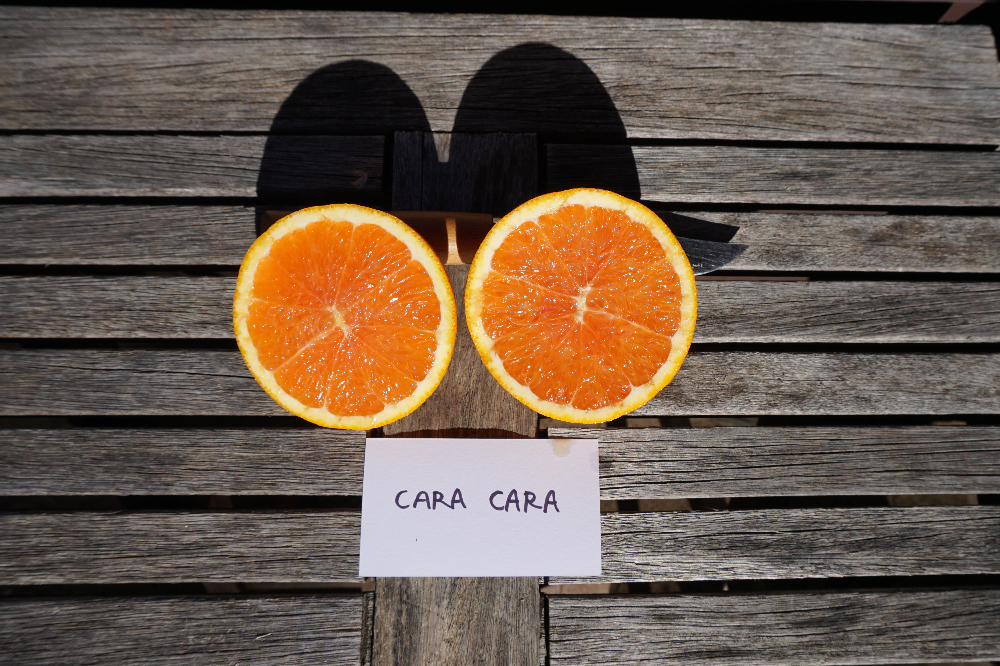
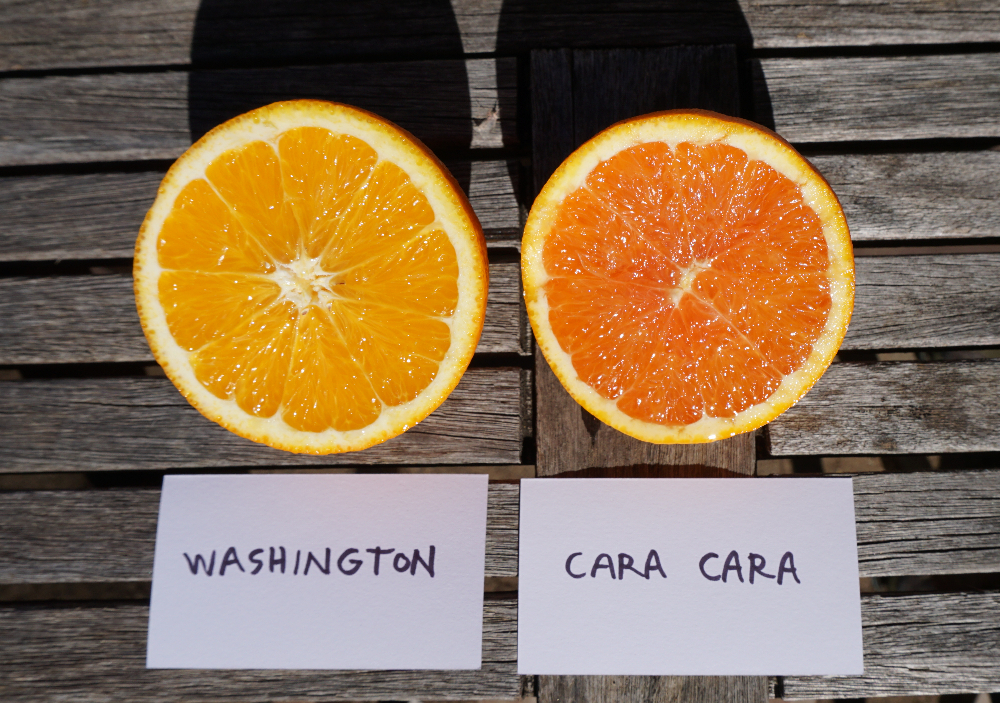
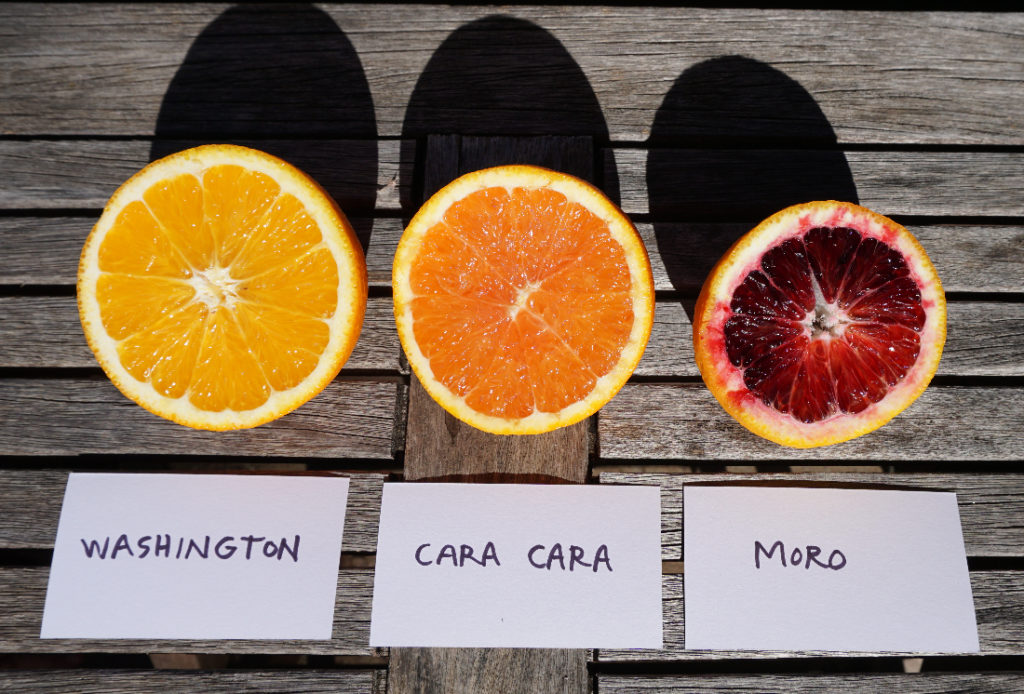

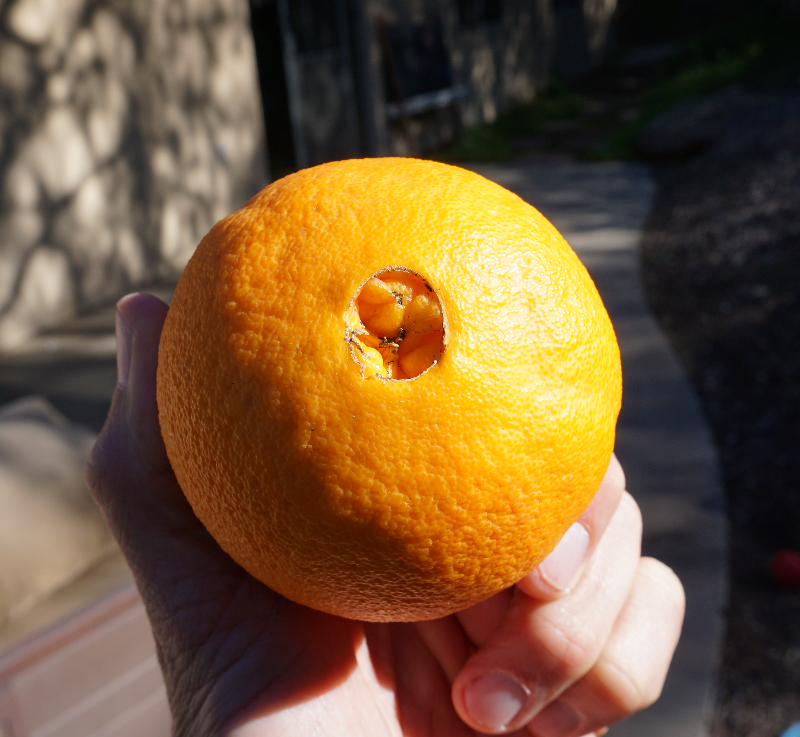
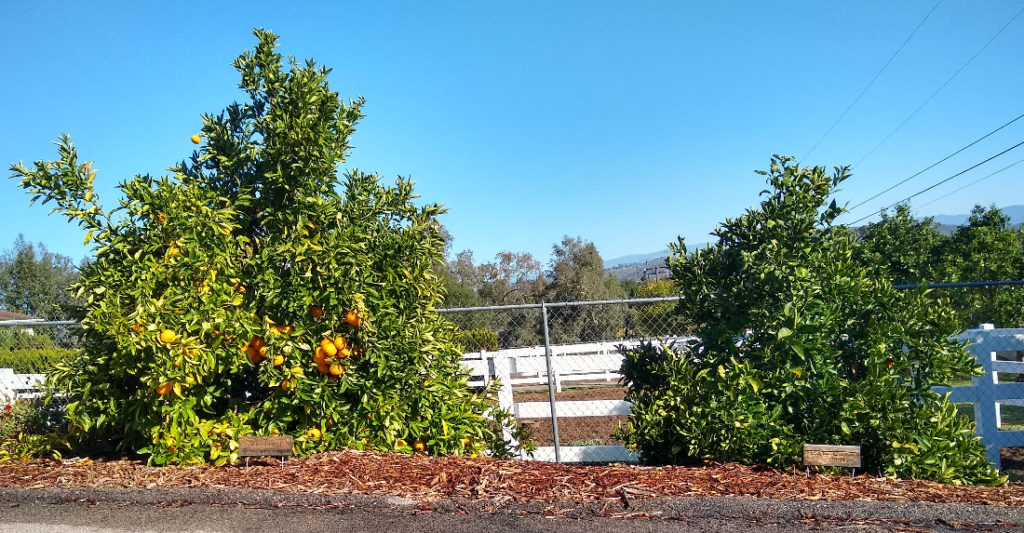



I have a Cara cara planted 3 years ago from a 5 gallon pot at home depot. It has not grown at all. It is 12-18 inches high and has stayed that way. It gets drip irrigation and direct sun from 7am to 1pm. Gives me no fruits. I give granular fertilizer 15-15-15 every 3 months. No infestation or disease looking leaves, but the leaves do look small. Plant doesn’t look sickly or dying. It’s just not thriving. I have no idea what I’m doing wrong. I’m in 10a and get occasional days in 110 F in August but highest temps are usually 100.
Hi Tin,
Your situation sounds familiar. I could have added to the post above that my current Cara Cara tree is actually my second. A year prior, I planted a Cara Cara that grew exactly like yours — that is, almost not at all. I removed it after one year. I don’t know what the problem was for sure, but my guess is it was with the roots. I found after scraping near the base of the trunk that a main root was kinked and growing in a circle rather than spoking outward. Sometimes at the nursery these trees don’t get potted up on time and the roots circle within smaller containers, later and slowly girdling other roots, and the tree will never thrive.
My lesson learned was to always scrape around the base of the trunk of a citrus tree before buying it to check for circling roots.
I don’t know if this is what is happening with your tree, but regardless, you should remove it and plant a new one. Cut your losses. Three years is plenty of time for the tree to show its potential, and I don’t see anything in your description that sounds like you’re caring for it improperly.
One last thought is that I hope it’s not growing in or surrounded by lawn. I have seen many citrus trees planted within a lawn that fail to thrive. Not that you can’t grow a citrus tree within a lawn, but if you try you must take extra steps to make sure the tree can outcompete the vigorous, hungry, and thirsty grass.
Do you think it’s worth trying to pull it out and then try to cut through the root ball, cutting through any girdling roots? I planted a pixie the same month and that one is exploding in growth. So difficult buying potted trees. You’d think seeing healthy leaves and branches would be enough.
Try cutting most of the limbs and leaves away – leave a short good one. Then dig the root ball out cutting it an inch smaller all around, or so it fits in a container. Have a pot ready with aged soil – soil you know it will grow in. Wet the soil and plant the tree in it. Don’t let it dry out and make sure it has good drainage. I’ve saved over 3 trees that way. My pink grapefruit was growing great then it was dying back. I dug it up and put it up on my embankment. It started growing nicely again. Then it had another setback – close to death. I put it in a 5 gallon planter as I stated and it started coming back. A year later I planted it close to the original location which has a layer of clay about 18″ down. I was thinking the drainage would not be ok, but I ate 4 great fruit off it this past year and it has a ton of new growth. I have it on a drip system and rarely give it any extra water. A month ago I dug up a Miho Satsuma that was degrading that has a nasty trunk. I put it in a 5 gal container and am working on bringing it back.
I live in Lodi California. I bought my Cara Cara in 2016 from Four Winds Nursery and it’s doing well. I also don’t pick my fruit until mid February. People seem to think that just because an orange is orange color that it is ripe which is not necessarily the case. I also have a grape which looks ripe but really needs another 2 months before it is ready to pick.
Love my Cara Cara tree. I planted it 4 years ago and it is maybe 30″ high and wide but yields about 15-20 pieces of fruit each year. It is definitely a slow grower. I am in Long Beach, CA and the fruit is usually ripe just before New Year. Thank you for sharing the story of the tree’s origins.
Hi, we live in San Diego and want to find a dwarf Cara Cara (not a semi dwarf). Have you heard of a true dwarf? Thank you!
Hi Caroline,
I would ask why you want a “true dwarf.” Often, it’s better to grow citrus on a stronger rootstock and prune the tree to the desired size rather than use a slow-growing (“dwarf”) rootstock like Flying Dragon. For example, I have a Bearss lime tree that is 13 years old but still only 5 feet tall because I keep it pruned to that size; it is very healthy and fruitful.
Check out my related post here: https://gregalder.com/yardposts/dwarf-semi-dwarf-and-standard-citrus-trees-what-are-they-really/
Also, Cara Cara navel orange trees are slow growing compared to many other citrus types. My Cara Cara is smaller than most of my other citrus of the same age, and I’ve seen the same happen in many other yards. I wouldn’t want to further slow it down with a weak rootstock.
We did a taste test of ours and your’s Greg. The verdict was that they tasted virtually the same despite pretty different growing zones. I agree with all of the above that mid feb is a good time to start picking them. I typically pick any citrus when they easily pop off the stem, way after the big orchards pick theirs. We have access to a huge Washington navel that we have to start picking in early January due to the fact that there are so many fruit. We’re still picking from it and probably will be all the way into March. Those things are like liquid candy.
Also, that’s a nice looking lavender gem in the picture above.
Cara Cara oranges are my absolute favorite. I live in Los Angeles, and would like to order one on-line. But everything on-line is from outside CA, and they can’t be shipped here. Does anyone know where I can order one online from a CA grower?
Hi Elizabeth,
Are you interested in fruit or a tree?
I ordered mine from Alderandoakplants.com online they are located in central California. Just got it today and I’m I. Orange County, Ca.
Thanks so much for telling me where I can get a Cara Cara orange tree in CA! I really appreciate it. I bought a Satsuma mandarin orange tree when I couldn’t get the one I really wanted. Now I plan to have both.
Hi Elizabeth, I know your post is from 2022. But I’m in Southern California and was able to buy one online from Four Winds Growers. https://www.fourwindsgrowers.com/products/cara-cara-sweet-orange-tree?variant=3756996395021
Hi. I am in Irvine. Where can I buy Cara Cara dwarf or semi dwarf tree? They are out of stock at Home Depot. Thanks
Hi Mai,
I would call Plant Depot in San Juan Capistrano to see if they have any in stock, or Laguna Hills Nursery in Santa Ana. Or call an Armstrong Nursery near you. There’s one in Irvine, another in Tustin, and one in Costa Mesa: https://www.armstronggarden.com/locations
Don’t bother requesting dwarf or semi-dwarf. The terms are nearly meaningless, and the trees labeled so are often essentially the same. Just keep the tree you buy to whatever size you want by pruning. More about that here: https://gregalder.com/yardposts/dwarf-semi-dwarf-and-standard-citrus-trees-what-are-they-really/
Have a beautifull 20 tree farm a d would e joy any info that you can send
Recently bought two Cara Caras and planted them here in Southern California. Both came from CA Growers. Moon Valley Nurseries in Escondido, CA (you can find their nurseries in multiple locations in Southern CA) and Four Winds Growers in Watsonville, CA. Nice healthy plants.
Based on what I see from my Davis home weather station, I live in an area that is more accurately described as Zone 8 but rated Zone 9. Usually I see 1-3 nights per winter where temps are in the high teens. Sometimes there is snow (4,000 feet) and nighttime winter temps range from the mid 20s to the mid 30s in January and February.
I first planted a Washington Orange thinking it might fare better but it never leafed out that well and the leaves curled significantly when exposed to the sun. It’s still hanging in there four years later, but by a thread. In winter I would drape it with a frost cloth and/or Christmas lights to try to overwinter it outdoors (in ground). Unfortunately, that meant never seeing blooms become fruit. Eventually I dug it up and tried to keep it as a container variety (semi-dwarf) but my success was even worse there, and I nearly killed it trying to overwinter the tree in my garage next to a large window, even with the help of artificial light.
Now I have Cara Cara and Improved Myer Lemon on C-34 “Flying Dragon” rootstock, which is supposedly able to tolerate down to Zone 6 (sold at Costco). For in-ground planting, do I need to be covering/heating my citrus anymore given that it is apparently on cold tolerant rootstock?